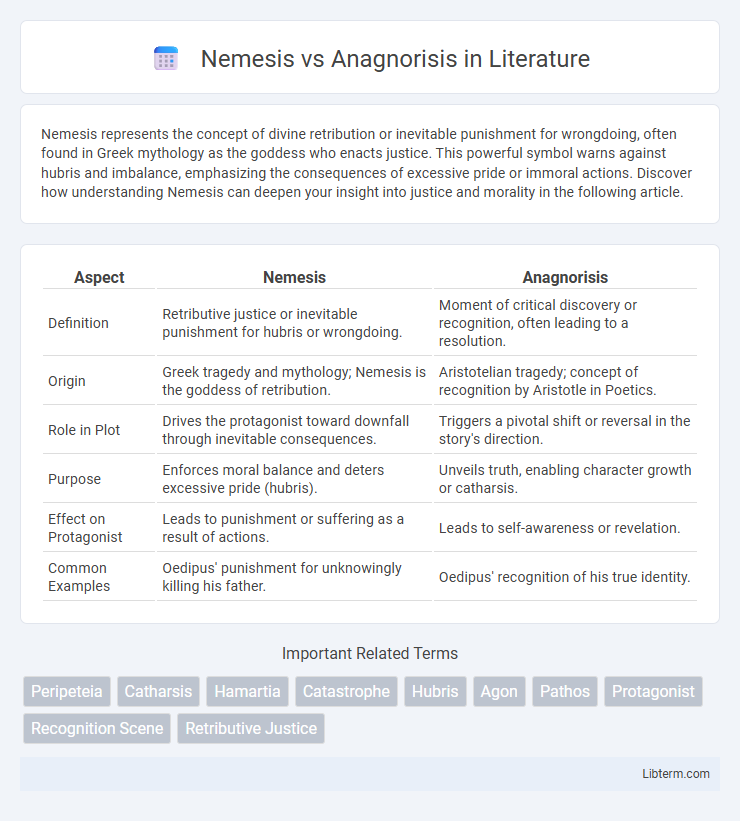Nemesis represents the concept of divine retribution or inevitable punishment for wrongdoing, often found in Greek mythology as the goddess who enacts justice. This powerful symbol warns against hubris and imbalance, emphasizing the consequences of excessive pride or immoral actions. Discover how understanding Nemesis can deepen your insight into justice and morality in the following article.
Table of Comparison
| Aspect | Nemesis | Anagnorisis |
|---|---|---|
| Definition | Retributive justice or inevitable punishment for hubris or wrongdoing. | Moment of critical discovery or recognition, often leading to a resolution. |
| Origin | Greek tragedy and mythology; Nemesis is the goddess of retribution. | Aristotelian tragedy; concept of recognition by Aristotle in Poetics. |
| Role in Plot | Drives the protagonist toward downfall through inevitable consequences. | Triggers a pivotal shift or reversal in the story's direction. |
| Purpose | Enforces moral balance and deters excessive pride (hubris). | Unveils truth, enabling character growth or catharsis. |
| Effect on Protagonist | Leads to punishment or suffering as a result of actions. | Leads to self-awareness or revelation. |
| Common Examples | Oedipus' punishment for unknowingly killing his father. | Oedipus' recognition of his true identity. |
Understanding Nemesis: Definition and Origins
Nemesis, originating from ancient Greek mythology, represents divine retribution against hubris or excessive pride, ensuring moral balance through punishment. This concept evolved into a symbolic force of vengeance and justice in literature, reflecting the inevitability of fate and consequences for one's actions. Understanding Nemesis is crucial for grasping its role in classical tragedies, where it serves as a catalyst for character downfall and thematic exploration of justice.
Anagnorisis Explained: Etymology and Dramatic Role
Anagnorisis, derived from the Greek word "anagnorisis" meaning "recognition" or "discovery," plays a crucial dramatic role by marking the protagonist's sudden realization of a critical truth. This moment often triggers a reversal of fortune, heightening the emotional intensity and advancing the plot in classical tragedies. Unlike Nemesis, the force of retributive justice, anagnorisis centers on internal insight rather than external punishment.
Nemesis in Classical Tragedy: Examples and Analysis
Nemesis in classical tragedy represents the inescapable retribution or divine punishment that befalls the protagonist, often due to hubris or moral transgression. Prominent examples include Sophocles' "Oedipus Rex," where Oedipus faces nemesis through the revelation of his unintended crimes leading to his downfall. This concept underscores the moral order in Greek tragedy by illustrating the inevitable consequences of human flaws and ethical failings, contrasting with Anagnorisis, which centers on the protagonist's moment of critical discovery or self-awareness.
Anagnorisis in Literature: Key Moments and Effects
Anagnorisis in literature serves as a pivotal moment of critical discovery where a character transitions from ignorance to knowledge, often triggering a profound shift in the narrative trajectory. This moment frequently unveils hidden truths or reveals the true nature of other characters, intensifying emotional responses and deepening thematic complexity. Key examples include Oedipus's realization of his identity in Sophocles' tragedy and the recognition scenes in Shakespearean plays, highlighting anagnorisis's role in driving catharsis and moral insight.
Comparing Nemesis and Anagnorisis: Core Differences
Nemesis represents the inevitable punishment or retribution characters face due to hubris or moral failings, while anagnorisis signifies the pivotal moment of self-awareness or critical discovery within a narrative. Nemesis drives the external consequences that shape the plot's resolution, whereas anagnorisis triggers internal transformation that often leads to recognition of truth or identity. Together, they highlight contrasting mechanisms of tragedy: Nemesis enforces justice through fate, and anagnorisis facilitates enlightenment through personal insight.
Interplay Between Nemesis and Anagnorisis in Storytelling
Nemesis and anagnorisis serve as pivotal narrative elements that shape character arcs and thematic resolution in storytelling. Nemesis represents the inevitable retribution faced by characters due to their hubris or moral failings, while anagnorisis marks the critical moment of self-awareness or recognition of truth. Their interplay intensifies dramatic tension as the protagonist's newfound insight during anagnorisis often precipitates nemesis, driving the story toward tragic or redemptive outcomes.
Iconic Characters Experience Nemesis and Anagnorisis
Iconic characters like Oedipus and Macbeth vividly illustrate the concepts of nemesis and anagnorisis through their tragic journeys. Oedipus experiences nemesis as his fate inexorably leads to his downfall, followed by anagnorisis when he recognizes his own tragic errors. Similarly, Macbeth's ambitious rise is met with nemesis through his eventual defeat, while his moment of anagnorisis reveals the futility of his quest for power.
Thematic Significance: Justice vs. Self-Discovery
Nemesis embodies the theme of justice by representing the inevitable punishment and moral retribution characters face for their hubris or wrongdoing, reinforcing societal order and ethical balance. In contrast, anagnorisis highlights self-discovery as a critical turning point where protagonists gain profound insight into their true nature or circumstances, often leading to personal transformation. Together, these concepts explore the tension between external consequences and internal realization, shaping the narrative's approach to character development and moral resolution.
Modern Interpretations: Nemesis and Anagnorisis Today
Modern interpretations of nemesis emphasize it as a manifestation of karmic justice, reflecting societal demands for accountability in contemporary narratives. Anagnorisis is often portrayed as a critical moment of self-awareness leading to personal growth or tragic catharsis, resonating with psychological themes in modern storytelling. Both concepts remain central to character development, influencing genres from drama to thriller in 21st-century literature and film.
Impact on Audience: Emotional and Ethical Resonance
Nemesis evokes intense emotional reactions by delivering poetic justice that satisfies the audience's need for moral balance, reinforcing societal values through retribution. Anagnorisis drives profound ethical reflection by revealing critical truths that challenge characters' and viewers' understanding, fostering empathy and moral growth. Together, these concepts deepen audience engagement by intertwining emotional catharsis with transformative insight, enhancing the overall impact of the narrative.
Nemesis Infographic

 libterm.com
libterm.com